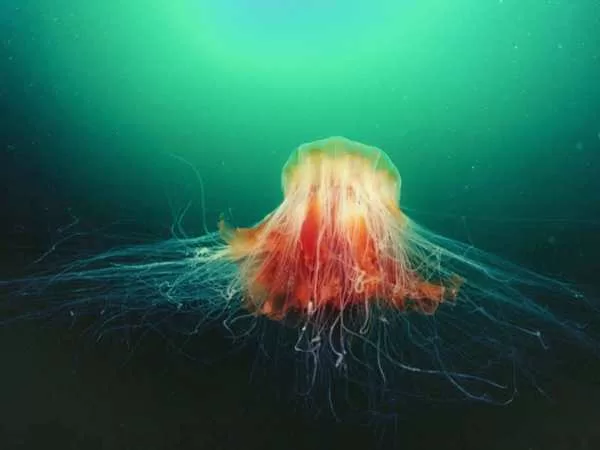Jellyfish have been gracing Earth’s oceans for an astonishing 650 million years, predating the dinosaurs and showcasing a remarkable persistence through time. These mesmerizing creatures continue to thrive in today’s oceans, flaunting an incredible diversity of sizes and shapes. Among them, the Lion’s Mane jellyfish stands out, both for its size and its fascinating characteristics. Let’s dive into the intriguing world of these ancient marine wonders.
The Ancient and Astonishing Jellyfish
Jellyfish are among the most primitive life forms on the planet. Remarkably simple, their bodies are composed of about 95% water, devoid of bones, cartilage, heart, blood, and even a brain. Imagine an organism that thrives without a brain—what seems like a biological impossibility is reality for jellyfish. Despite their simplicity, jellyfish are sophisticated predators and vital components of marine ecosystems.
The Lion’s Mane jellyfish, a species notable for its impressive size and long, flowing tentacles, is a prime example of this ancient lineage. While smaller specimens are common, the record-holder was a colossal creature found washed ashore. This giant specimen highlights the potential size of these remarkable jellyfish.
Sensory Surprises: Eyes Without Brains
One of the most perplexing aspects of jellyfish, including the Lion’s Mane, is their sensory capabilities despite the absence of a central brain. Scientists have discovered that some jellyfish possess rudimentary eyes that can detect light and even discern movement. This raises an intriguing question: How can a creature with no brain process visual stimuli?
Research into jellyfish vision provides valuable insights into sensory processing. While jellyfish lack a centralized brain, their ability to respond to environmental changes demonstrates that simpler organisms can still perceive and react to their surroundings in sophisticated ways. Studying these mechanisms helps scientists understand the fundamental processes of vision and neural function.
Silent Predators of the Deep
The Arctic Lion’s Mane jellyfish exemplifies the predatory nature of these enigmatic creatures. Despite their seemingly passive appearance, they are skilled hunters, preying on fish, plankton, and even other jellyfish. The hunting strategy of the Lion’s Mane is particularly fascinating.
Jellyfish, including the Lion’s Mane, use their tentacles—armed with millions of nematocysts, or stinging cells—to capture prey. When a fish or other creature comes into contact with these tentacles, a venomous sting is delivered, paralyzing the victim almost instantly. This venom allows the jellyfish to consume its prey at its own pace. The tentacles effectively deliver the meal directly to the jellyfish, minimizing the need for active pursuit.
Interestingly, Lion’s Mane jellyfish also engage in cannibalism, feeding on other jellyfish. This behavior highlights their adaptability and the competitive nature of the marine food chain. However, despite their predatory prowess, Lion’s Mane jellyfish themselves face threats from other marine creatures.
The Perils of the Lion’s Mane Sting
While the Lion’s Mane jellyfish is a fascinating and vital part of the oceanic ecosystem, it poses significant risks to humans. A sting from this giant jellyfish can be extremely painful and potentially deadly. The venom, potent enough to paralyze breathing muscles, can lead to suffocation and death if not treated promptly.
Fortunately, encounters with these giant jellyfish are relatively rare for beachgoers. The largest specimens of the Lion’s Mane typically inhabit the deep, frigid waters of the Arctic, far from typical recreational swimming areas. However, their presence in colder regions of the ocean underscores the diverse and sometimes dangerous nature of marine life.
The Lion’s Mane in Context
The Lion’s Mane jellyfish represents just one aspect of the vast and mysterious world of jellyfish. These ancient creatures have adapted to a wide range of marine environments and continue to play crucial roles in ocean ecosystems. Their resilience and adaptability make them fascinating subjects for scientific study and highlight the complexity of life in the oceans.
The study of jellyfish, particularly species like the Lion’s Mane, offers valuable insights into the evolution of sensory systems, predatory behaviors, and ecological interactions. As we continue to explore and understand these remarkable creatures, we gain a deeper appreciation for the intricate web of life that exists beneath the waves.
In summary, the Lion’s Mane jellyfish stands as a testament to the enduring marvels of marine life. From its ancient origins to its complex behaviors and unique sensory adaptations, this jellyfish captivates and challenges our understanding of the natural world. As we delve into the mysteries of these enigmatic creatures, we uncover not only the secrets of the deep but also the remarkable resilience of life on Earth.

